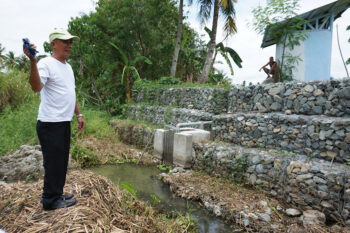 Kagawad Danilo Casa of Brgy. Biwang, Bagumbayan, Sultan Kudarat shows the intake structure with gabions of the solar-powered irrigation project site in his brother’s farm. MindaNews photo by H. MARCOS C. MORDENO
Kagawad Danilo Casa of Brgy. Biwang, Bagumbayan, Sultan Kudarat shows the intake structure with gabions of the solar-powered irrigation project site in his brother’s farm. MindaNews photo by H. MARCOS C. MORDENO
BAGUMBAYAN, Sultan Kudarat (MindaNews / 06 April) – At least four Solar-Powered Irrigation System (SPIS) facilities of the Department of Agriculture in Sultan Kudarat and North Cotabato which would have helped reduce crop damage during the dry spell have remained untapped.
The four SPIS units MindaNews visited on April 3 cost 5 to 8 million pesos each and are located in barangays Biwang in Bagumbayan and D. Lotilla in Isulan, both in Sultan Kudarat province, and New Janiuay and Palma Perez in M’lang, North Cotabato. They are among 10 SPIS projects for rice farms in Region 12.
The facilities are supposed to impound water into a reservoir measuring an average of 350 cubic meters each.
But Sammy Casa, a farmer in Biwang, said the facility has not been used after its completion in November last year, as it has yet to be turned over to them by the DA.
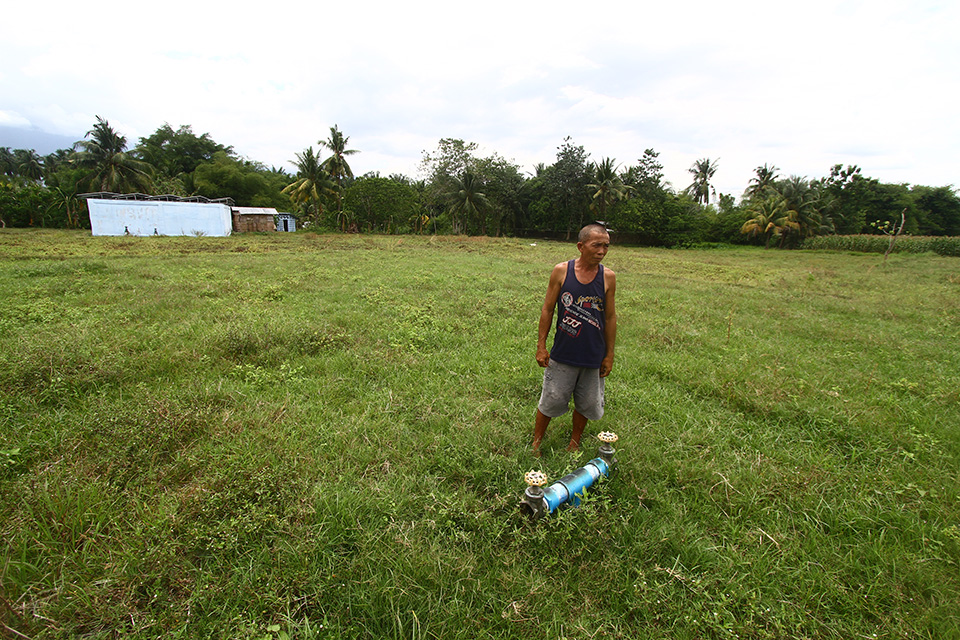 Farmer Sammy Casa stands beside one of the gate valves of the Solar Powered Irrigation Sysytem (SPIS) in Barangay Biwang, Bagumbayan Sultan Kudarat on April 3, 2019. Casa and other beneficiaries are still waiting for the turnover of the P5-million SPIS project that could have been used to irrigate their farmlands amid El Niño. Photo courtesy of Keith Bacongco
Farmer Sammy Casa stands beside one of the gate valves of the Solar Powered Irrigation Sysytem (SPIS) in Barangay Biwang, Bagumbayan Sultan Kudarat on April 3, 2019. Casa and other beneficiaries are still waiting for the turnover of the P5-million SPIS project that could have been used to irrigate their farmlands amid El Niño. Photo courtesy of Keith Bacongco
Casa donated a portion of his farm on which the facility stands, beside the creek which would serve as the water source.
His brother, barangay councilor Danilo Casa, said he was informed by an official of the DA that construction of the SPIS should be done during the dry season “so that the contractor would know how low the water level will be and they can adjust the placement of the pipes,” he explained.
He said the construction began in July last year, a rainy month.
In nearby Brgy. D. Lotilla in Isulan town, the solar-powered irrigation facility has yet to be turned over, too. It was finished in February.
D. Lotilla barangay chair Ricardo Lotilla said the turnover was put on hold as the contractor has yet to receive full payment for the project.
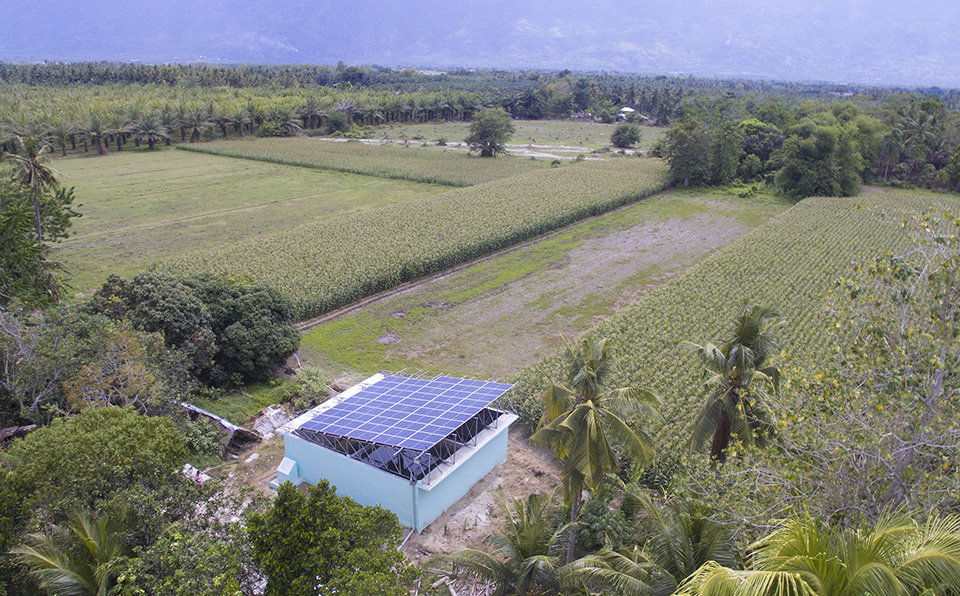 The P5.3-million Solar Powered Irrigation System (SPIS) in Barangay Barangay D.Lotilla in Isulan, Sultan Kudarat. Farmers are still waiting for a word from the DEpartment of Agriculture Region 12 as to when this would be turned over to them. April 3, 2019. Photo courtesy of Keith Bacongco
The P5.3-million Solar Powered Irrigation System (SPIS) in Barangay Barangay D.Lotilla in Isulan, Sultan Kudarat. Farmers are still waiting for a word from the DEpartment of Agriculture Region 12 as to when this would be turned over to them. April 3, 2019. Photo courtesy of Keith Bacongco
Engr. Erwin Arguelles, Chief of the Engineering Division of DA-12, told MindaNews in a telephone interview Friday evening that the contractor has to fix the distribution pipes.
Lotilla said the facility worked well during a dry run held last month.
Instead of surface water like in Biwang, the facility in D. Lotilla relies on groundwater drawn through a pump.
In M’lang, North Cotabato, the hometown of Agriculture Secretary Emmanuel Pinol, the solar-powered irrigation structures have yet to be tapped, too. The New Janiuay SPIS was the first among 169 targeted SPIS projects and was inaugurated by President Rodrigo Duterte in February 2017.
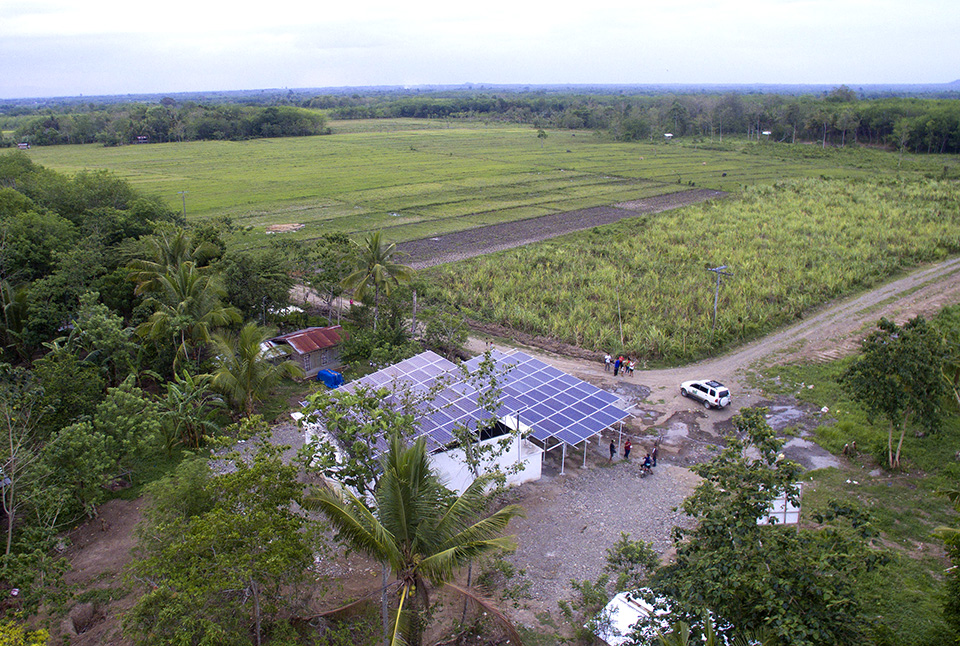 The newly-commissioned P7.9-million System (SPIS) in Barangay Palma Perez, Mlang, North Cotabato. Photo courtesy of Keith Bacongco
The newly-commissioned P7.9-million System (SPIS) in Barangay Palma Perez, Mlang, North Cotabato. Photo courtesy of Keith Bacongco
The one in Brgy. Palma Perez, inaugurated on March 29 this year, stands some 200 meters away from the Malasila River. It is the biggest among the four, with a 25-horsepower pump. But there are no distribution pipes.
Arguelles said distribution will be done through an open canal. He said 220 meters of pipes were used from the Malasila River to the SPIS.
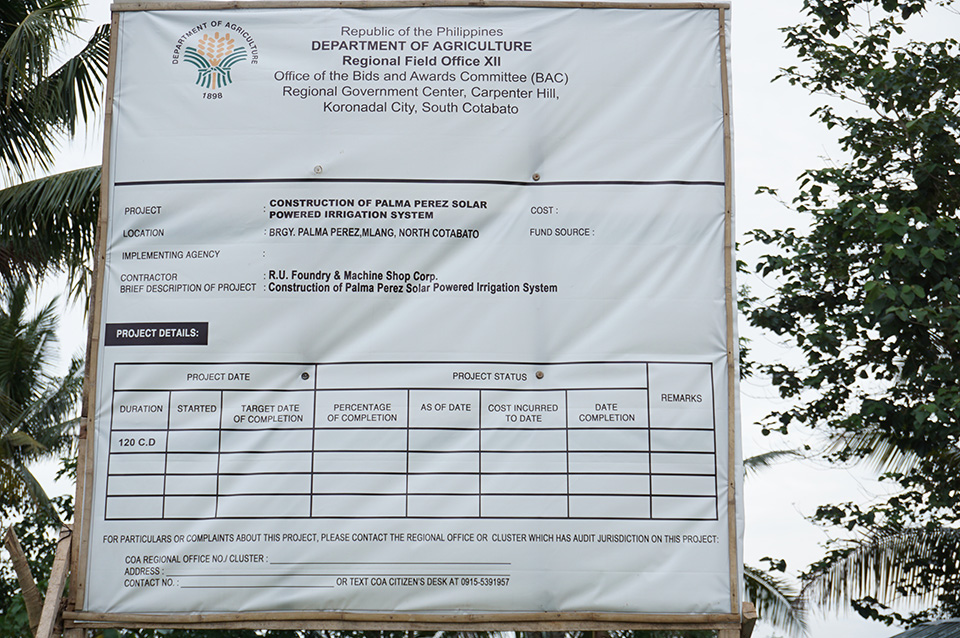 Except for the official duration, a tarp on the SPIS project in Brgy. Palma Perez in M’lang, North Cotabato does not mention the other details. Photo taken April 3, 2019. Mindanews Photo by H. Marcos C. Mordeno
Except for the official duration, a tarp on the SPIS project in Brgy. Palma Perez in M’lang, North Cotabato does not mention the other details. Photo taken April 3, 2019. Mindanews Photo by H. Marcos C. Mordeno
The unit in Brgy. New Janiuay sits adjacent to a pond which serves as a fish culture area of the Jugos family.
New Janiuay barangay chair Judy Palmares pointed out that the pond, the supposed water source for the reservoir, relies on rainwater not on an underground source such as a spring.
“If it doesn’t rain, there would be no water in it,” she said.
On Wednesday, the water level at the pond, which is smaller than a soccer field, barely reached four feet high.
She said the SPIS was not even able to sustain the water requirement of the farm just beside it because there was only little water in the pond when the rice plants were about to bear grains.
She said the farmers expressed dismay that they could not make use of the facility during the dry spell.
Palmares also said the farmers complained they were not consulted on where to locate the project.
She added the project started under the previous barangay administration. She took over as barangay chair in 2018.
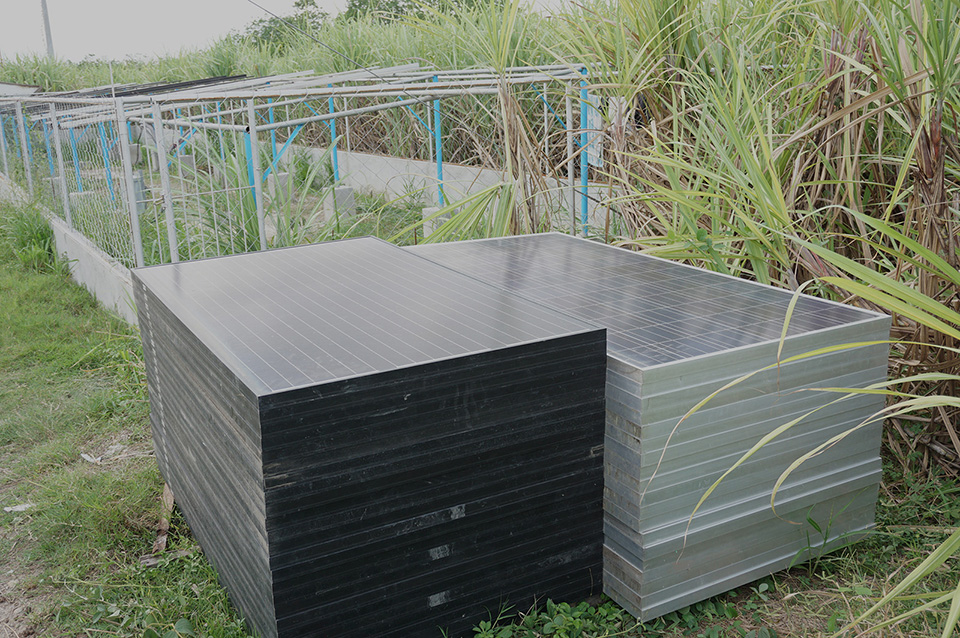 The solar-powered irrigation structure in Barangay New Janiuay, M’lang, North Cotabato without the solar panels. MindaNews photo by H. MARCOS C. MORDENO
The solar-powered irrigation structure in Barangay New Janiuay, M’lang, North Cotabato without the solar panels. MindaNews photo by H. MARCOS C. MORDENO
MindaNews noticed during the site visit on April 3 that the solar panels of the SPIS facility in New Janiuay had been dismantled.
Arguelles said the DA is not the implementing agency of that project but he said he was informed that the panels were to be moved to an area nearer the water source as part of the rectification process.
All SPIS facilities in the four barangays are not equipped with batteries that will store power that can be used at nighttime or during daytime in case of cloudy or rainy weather.
Arguelles said batteries would involve maintenance and would entail additional cost for the farmers. He explained that the solar panels generate power even if it is cloudy, although not at its peak capacity.
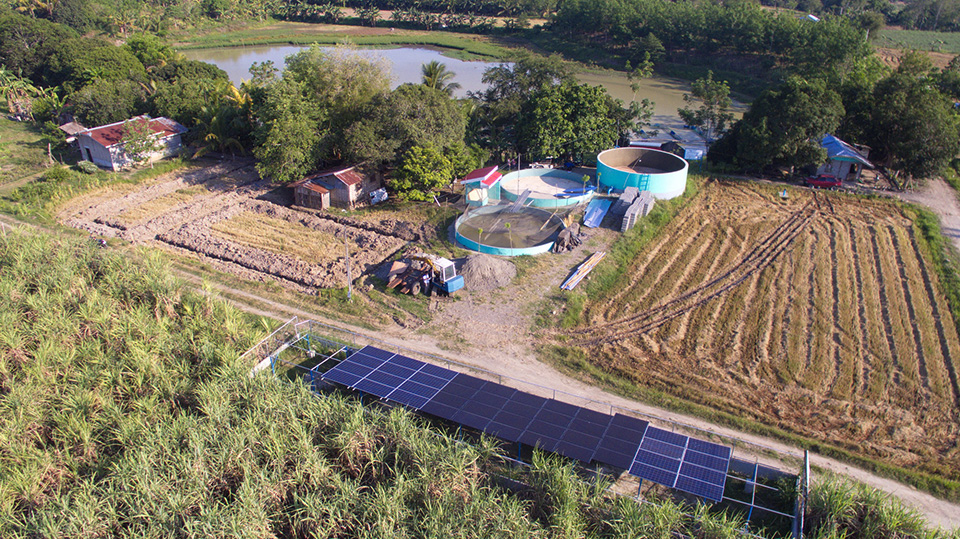 The P7.9-million Solar Powered Irrigation System (SPIS) in Barangay New Janiuay in M’lang, North Cotabato Province is rendered useless for lack of water supply due to El Niño. Photo taken on March 25, 2019. Photo courtesy of Keith Bacongco
The P7.9-million Solar Powered Irrigation System (SPIS) in Barangay New Janiuay in M’lang, North Cotabato Province is rendered useless for lack of water supply due to El Niño. Photo taken on March 25, 2019. Photo courtesy of Keith Bacongco
In his Facebook post on March 30, Pinol said there is “a need to change our mindset on the system of irrigation to be used in providing water to our farms.”
Since huge dams take years to complete “the most logical option would be the sustainable small irrigation projects like the Solar-Powered Irrigaton System, Ram Pumps where these are applicable and even windmill-powered water pumps.”
“This option provides faster response to the threat of El Niño or the drought,” he said. (H. Marcos C. Mordeno/MindaNews with a report from Carolyn O. Arguillas)
Read:
SPECIAL REPORT
Solar-Powered Irrigation System: Proposed solution fails to serve farmers in the time of El Nino
